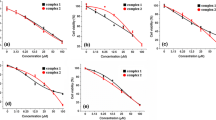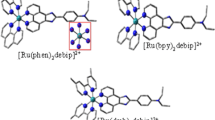Abstract
Using DFT treatment based on the B3LYP hybrid functional, the nearly spherical structure of [Ti7O28H26]2−, the rod-like structures of [Ti2O10H10]2−, and [Ti7O30H10]2− chains in singlet ground spin states and the structures of their neutral complexes with Cu2+ ions coordinated at various terminal or bridging oxygen sites in doublet ground spin states are optimized in order to assess the toxicity of rutile nanoparticles of various shapes. For this purpose Cu-ligand interaction energy parameters and Cu charges in the above systems under study are evaluated. Spherical structures are more reactive than the rod-like chains of the (nearly) same size. The reverse relation holds for the degree of their toxicity as indicated by the extent of the electron density transfer to a Cu2+ probe. The experimentally observed higher cytotoxicity of the rod-like nanoparticles in comparison with the spherical ones might be explained by the higher electron density transfer to the interacting cells.

Graphical abstract







Similar content being viewed by others
References
Alagona G, Ghio C (2009a) Antioxidant properties of pterocarpans through their copper(II) coordination ability. A DFT study in vacuo and in aqueous solution. J Phys Chem A 113:15206–15216
Alagona G, Ghio C (2009b) Plicatin B conformational landscape and affinity to copper (I and II) metal cations. A DFT study. Phys Chem Chem Phys 11:776790
Becke AD (1993) Density-functional thermochemistry .3. The role of exact exchange. J Chem Phys 98:5648–5652
Benetti G, Cavaliere E, Brescia R, Salassi S, Ferrando R, Vantomme A, Pallecchi L, Pollini S, Boncompagni S, Fortuni B, Van Bael MJ, Banfi F, Gavioli L (2019) Tailored Ag-Cu-Mg multielemental nanoparticles for wide-spectrum antibacterial coating. Nanoscale 11:1626–1635
Breza M, Šimon P (2019) Quantum-chemical studies of rutile nanoparticles toxicity I. Defect-free rod-like model clusters. Acta Chim Slovaca 12:168–174
Cioslowski J (1989) A new population analysis based on atomic polar tensors. J Am Chem Soc 111:8333–8336
Dapprich S, Komáromi I, Byun KS, Morokuma K, Frisch MJ (1999) A new ONIOM implementation in Gaussian98. Part I. The calculation of energies, gradients, vibrational frequencies and electric field derivatives. J Mol Struct (THEOCHEM) 462:1–21
Diebold U (2003) The surface science of titanium dioxide. Surf Sci Rep 48:53–229
Elgrabli D, Beaudouin R, Jbilou N, Floriani M, Pery A, Rogerieux F, Lacroix G (2015) Biodistribution and clearance of TiO2 nanoparticles in rats after intravenous injection. PLoS One 10:e0124490
Fabian E, Landsiedel R, Ma-Hock L, Wiench K, Wohlleben W, van Ravenzwaay B (2008) Tissue distribution and toxicity of intravenously administered titanium dioxide nanoparticles in rats. Arch Toxicol 82:151–157
Forest V, Leclerc L, Hochepie JF, Trouvé A, Sarry G, Pourchez J (2017) Impact of cerium oxide nanoparticles shape on their in vitro cellular toxicity. Toxicol Vitro 38:136–141
Frisch MJ, Trucks GW, Schlegel HB et al (2013) Gaussian 09 (Revision D.01). Gaussian Inc, Wallingford
Geraets L, Oomen AG, Krystek P, Jacobsen NR, Wallin H, Laurentie M, Verhaeren HW, Brandon EFA, de Jong WH (2014) Tissue distribution and elimination after oral and intravenous administration of different titanium dioxide nanoparticles in rats. Part Fibre Toxicol 11:0030
Hanaor DAH, Assadi MHN, Li S, Yu A, Sorrell CC (2012a) Ab initio study of phase stability in doped TiO2. Comput Mech 50:185–194
Hanaor DAH, Xu W, Ferry M, Sorrell CC (2012b) Abnormal grain growth of rutile TiO2 induced by ZrSiO4. J Cryst Growth 359:83–91
Hsiao I-L, Huang Y-J (2011) Effects of various physicochemical characteristics on the toxicities of ZnO and TiO nanoparticles toward human lung epithelial cells. Sci Total Environ 409:1219–1228
Huang Y-W, Cambre M, Lee H-J (2017) The toxicity of nanoparticles depends on multiple molecular and physicochemical mechanisms. Int J Mol Sci 18:2702
Hussain H, Tocci G, Woolcot T, Torrelles X, Pang CL, Humphrey DS, Yim CM, Grinter DC, Cabailh G, Bikondoa O, Lindsay R, Zegenhagen J, Michaelides A, Thornton G (2017) Structure of a model TiO2 photocatalytic interface. Nature Mater 16:461–466
Jiang J, Oberdorster G, Elder A, Gelein R, Mercer P, Biswas P (2008) Does nanoparticle activity depend upon size and crystal phase? Nanotoxicol 2:33–42
Lee JH, Ju JE, Kim BI, Pak PJ, Choi EK, Lee HS, Chung N (2014) Rod-shaped iron oxide nanoparticles are more toxic than sphere-shaped nanoparticles to murine macrophage cells. Environ Toxicol Chem 33:2759–2766
Mammino L (2013) Investigation of the antioxidant properties of hyperjovinol A through its Cu(II) coordination ability. J Mol Model 19:21277–22142
McLean D, Chandler GS (1980) Contracted gaussian-basis sets for molecular calculations .1. 2nd row atoms, Z=11–18. J Chem Phys 72:5639–5648
Mulliken RS (1955) Electronic population analysis on LCAO-MO molecular wave functions. J Chem Phys 23:1833–1840
Olmedo D, Guglielmotti MB, Cabrini RL (2002) An experimental study of the dissemination of titanium and zirconium in the body. J Mater Sci 13:793–796
Puškárová I, Breza M (2016) DFT studies of the effectiveness of p-phenylenediamine antioxidants through their Cu(II) coordination ability. Polym Degrad Stab 128:15–21
Raghavachari K, Binkley JS, Seeger R, Pople JA (1980) Self-consistent molecular-orbital methods . 20. Basis set for correlated wave-functions. J Chem Phys 72:650–654
Reed AE, Curtiss LA, Weinhold F (1988) Intermolecular interactions from a natural bond orbital, donor-acceptor viewpoint. Chem Rev 88:899–926
Wachters AJH (1970) Gaussian basis set for molecular wavefunctions containing third-row atoms. J Chem Phys 52:1033–1036
Wang JX, Zhou GQ, Chen CY, Yu HW, Wang TC, Ma YM, Jia G, Gao Y, Li B, Sun J, Li Y, Jiao F, Zhao Y, Chai Z (2007) Acute toxicity and biodistribution of different sized titanium dioxide particles in mice after oral administration. Toxicol Let 168:176–185
Wang Y, Chen Z, Ba T, Pu J, Chen T, Song Y, Gu YG, Qian Q, Xu YY, Xiang K, Wang HF, Jia G (2013) Susceptibility of young and adult rats to the oral toxicity of titanium dioxide nanoparticles. Small 9:1742–1752
Xie G, Wang C, Zhong G (2011) Tissue distribution and excretion of intravenously administered titanium dioxide nanoparticles. Toxicol Lett 205:55–61
Zhang Z, Fenter P, Sturchio NC, Bedzyk MJ, Machesky ML, Wesolowski DJ (2007) Structure of rutile TiO2 (110) in water and 1 molal Rb+ at pH 12: inter-relationship among surface charge, interfacial hydration structure, and substrate structural displacements. Surf Sci 601:1129–1143
Acknowledgments
We thank the HPC center at the Slovak University of Technology in Bratislava, which is a part of the Slovak Infrastructure of High Performance Computing (SIVVP Project ITMS 26230120002 funded by the European Region Development Funds) for computing facilities.
Funding
This project has received funding from the European Union’s Horizon 2020 research and innovation programme under grant agreement No. 685817 (HISENTS) and from Slovak Grant Agency VEGA (contract no. 1/0139/20).
Author information
Authors and Affiliations
Corresponding author
Ethics declarations
Conflict of interest
The authors declare that they have no conflict of interest.
Additional information
Publisher’s note
Springer Nature remains neutral with regard to jurisdictional claims in published maps and institutional affiliations.
In the memory of Prof. Peter Pelikan (1939–2002)
Electronic supplementary material
Supplementary data contain calculated energy terms of the systems under study and the coordinates of the optimized structures of 1[Ti7O28H26]2−—model A, 1[Ti2O10H10]2—model B, and 1[Ti7O30H10]2−—model C.
ESM 1
(PDF 222 kb)
Rights and permissions
About this article
Cite this article
Breza, M., Šimon, P. On shape dependence of the toxicity of rutile nanoparticles. J Nanopart Res 22, 58 (2020). https://doi.org/10.1007/s11051-020-4773-1
Received:
Accepted:
Published:
DOI: https://doi.org/10.1007/s11051-020-4773-1




